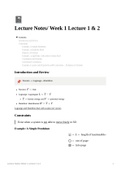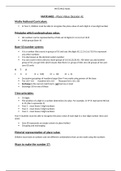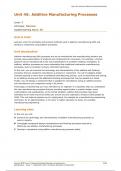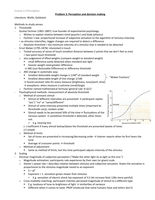CVEN3501 Notes – Water Resources
Engineering
Water and Energy Cycles
THE HYDROLOGICAL CYCLE
• The hydrological cycle depicts the distribution and variation of water
between the land, ocean and atmospheric spheres of the globe
o The typical model describes the storage and transformation of
water between reservoirs (i.e. ocean, atmosphere) via various
physical processes
• Over 70% of the surface of the Earth is covered with water, equivalent to
about 1.36*109km3 of water
• Water is the only known substance that occurs naturally in all three
phases naturally on Earth
• Water has a particularly high specific heat and maintains maximum
density in liquid form
• Distribution of fresh water on Earth is as follows:
o 3% of global water is fresh water
o 0.3% of fresh water is easily drinkable (surface water)
• The change in water volume in a reservoir is simply: delta(V) =
Flux*Time
• Around 86% of the worlds evaporation occurs over the oceans
• 80% of the worlds precipitation reaches the oceans
• 7% of the land based precipitation returns to the oceans via runoff
• The rate of change of atmospheric water volume is equal to:
delta(V)/delta(t) = ETocean + ETland – P
• The amount of time that a sample of water will reside in a given reservoir
is known as the residence time and is calculated by dividing the total
volume by the flux rate
HYDROLOGY IN AUSTRALIA
• Rainfall in Australia is among the lowest in the world
• Australia has a notoriously low precipitation and high evaporation,
which leads to droughts and seasonal river systems
• The climate in Australia varies drastically on an annual basis due to the
influence El Nino Southern Oscillation (ENSO)
o ENSO affects the frequency of tropical cyclones, heatwaves and
bushfires around the nation
ENERGY CYCLES
• The five major cycles which influence the hydrological cycles are:
o Radiation balance
o Vertical energy balance
o Latitudinal balance
o Seasonal and diurnal cycles
o Greenhouse effect
,RADIATION CYCLE
• Radiation is the emission of energy from an object in the form of
electromagnetic waves
• Electromagnetic radiation is the only method of energy transferal that
can occur in a vacuum i.e. outer space
o EM radiation occurs at the speed of light
• All objects at a temperature above absolute zero (-273.15 degrees
Celsius) will radiate energy
• Each type of radiation can be termed depending on its wavelength and
frequency, with wavelength being inversely proportional to
frequency
• The Sun emits radiation across a broad range of wavelengths and
frequencies, with the peak output occurring at the visible light range
• The EM radiation expelled per unit of surface area is directly related to
temperature: E = m*T4 where m=Stephan-Boltzmann constant
(5.67*10-8Wm-2K-4) and T=Temperature
• There is a relationship between the temperature of an object and its
peak radiation wavelength which is inversely proportional
o This is known as Wein’s Law: Wavelength*Temperature=2877
micrometres
o The higher the temperature, the shorter the peak wavelength of its
radiation
o For example, the Sun’s surface at 6000K releases a peak radiation
of 2 micrometres whereas mammals at 300K release peak
radiation of 10 micrometres
• The basic units of energy used to calculate radiation is as follows:
o Joule (energy) – Work done to move an object by 1m with 1N of
force
o Power (energy per time) – 1 Joule per second = 1 Watt
, o Flux (power per area) – 1 Watt per metre squared
• The equator of the Earth receives the greatest flux because there is no
angle between plane of interception with the Sun
o This explains why the poles are much cooler than the equator
• The solar constant of 1400W/m2 is the intensity of solar radiation
received at the top of the Earth’s atmosphere directly above the equator
• The net radiation is the sum of all incoming and outgoing longwave and
shortwave radiation
• The total solar radiation received by Earth is simply the solar constant
multiplied by the cross sectional area of the planet that faces the Sun
o Dividing this through by the surface area of the Earth outputs the
average solar radiation received per square metre upon the
surface of 350W/m2
• Only a fraction of the solar radiation received is actually absorbed to
cause heating of the Earth, a certain percentage is reflected
• Albedo is the ratio between: Reflected/Incoming Short-wave Radiation
(the average albedo on Earth is 30%)
• Emissivity is the proportion of long-wave radiation that reflects from the
Earth’s surface
• Due to conservation of energy, the approximately 70% of solar radiation
that is absorbed by the Earth simply results in a heating of the surface
o Since Earth’s surface is at a temperature above absolute zero, it
will attempt to reach equilibrium by releasing absorbed solar
radiation back into outer space (known as terrestrial radiation)
o Energy absorbed by Earth’s surface always equals the energy
emitted from the surface
• Around 19% of all solar radiation reaching Earth is absorbed within the
atmosphere
SEASONAL CYCLES
• The axis of rotation of the Earth is tilted 23.5 degrees away from the plane
of orbit with the Sun
• This tilt causes the two tropics on Earth; the Tropic of Cancer at 23.5
degrees North and the Tropic of Capricorn at 23.5 degrees South
• The tilt also induces seasonal equinoxes and solstices, which affect the
amount of daylight received by various regions of the Earth
• There is much higher amounts of solar radiation received between
the tropics than there is at the poles, which would appear to negate the
conservation of energy
o This creates a flow of energy from the equator to the poles, known
as a Hadley cell
• The creation of a Hadley cell is aided by convection, which naturally
transports energy from warmer objects to cooler objects
• The simple concept of a Hadley cell is complicated by the Coriolis effect,
which arises due to the west-east rotation of the Earth
PROCESSES AFFECTING THE HYDROLOGICAL CYCLE
Engineering
Water and Energy Cycles
THE HYDROLOGICAL CYCLE
• The hydrological cycle depicts the distribution and variation of water
between the land, ocean and atmospheric spheres of the globe
o The typical model describes the storage and transformation of
water between reservoirs (i.e. ocean, atmosphere) via various
physical processes
• Over 70% of the surface of the Earth is covered with water, equivalent to
about 1.36*109km3 of water
• Water is the only known substance that occurs naturally in all three
phases naturally on Earth
• Water has a particularly high specific heat and maintains maximum
density in liquid form
• Distribution of fresh water on Earth is as follows:
o 3% of global water is fresh water
o 0.3% of fresh water is easily drinkable (surface water)
• The change in water volume in a reservoir is simply: delta(V) =
Flux*Time
• Around 86% of the worlds evaporation occurs over the oceans
• 80% of the worlds precipitation reaches the oceans
• 7% of the land based precipitation returns to the oceans via runoff
• The rate of change of atmospheric water volume is equal to:
delta(V)/delta(t) = ETocean + ETland – P
• The amount of time that a sample of water will reside in a given reservoir
is known as the residence time and is calculated by dividing the total
volume by the flux rate
HYDROLOGY IN AUSTRALIA
• Rainfall in Australia is among the lowest in the world
• Australia has a notoriously low precipitation and high evaporation,
which leads to droughts and seasonal river systems
• The climate in Australia varies drastically on an annual basis due to the
influence El Nino Southern Oscillation (ENSO)
o ENSO affects the frequency of tropical cyclones, heatwaves and
bushfires around the nation
ENERGY CYCLES
• The five major cycles which influence the hydrological cycles are:
o Radiation balance
o Vertical energy balance
o Latitudinal balance
o Seasonal and diurnal cycles
o Greenhouse effect
,RADIATION CYCLE
• Radiation is the emission of energy from an object in the form of
electromagnetic waves
• Electromagnetic radiation is the only method of energy transferal that
can occur in a vacuum i.e. outer space
o EM radiation occurs at the speed of light
• All objects at a temperature above absolute zero (-273.15 degrees
Celsius) will radiate energy
• Each type of radiation can be termed depending on its wavelength and
frequency, with wavelength being inversely proportional to
frequency
• The Sun emits radiation across a broad range of wavelengths and
frequencies, with the peak output occurring at the visible light range
• The EM radiation expelled per unit of surface area is directly related to
temperature: E = m*T4 where m=Stephan-Boltzmann constant
(5.67*10-8Wm-2K-4) and T=Temperature
• There is a relationship between the temperature of an object and its
peak radiation wavelength which is inversely proportional
o This is known as Wein’s Law: Wavelength*Temperature=2877
micrometres
o The higher the temperature, the shorter the peak wavelength of its
radiation
o For example, the Sun’s surface at 6000K releases a peak radiation
of 2 micrometres whereas mammals at 300K release peak
radiation of 10 micrometres
• The basic units of energy used to calculate radiation is as follows:
o Joule (energy) – Work done to move an object by 1m with 1N of
force
o Power (energy per time) – 1 Joule per second = 1 Watt
, o Flux (power per area) – 1 Watt per metre squared
• The equator of the Earth receives the greatest flux because there is no
angle between plane of interception with the Sun
o This explains why the poles are much cooler than the equator
• The solar constant of 1400W/m2 is the intensity of solar radiation
received at the top of the Earth’s atmosphere directly above the equator
• The net radiation is the sum of all incoming and outgoing longwave and
shortwave radiation
• The total solar radiation received by Earth is simply the solar constant
multiplied by the cross sectional area of the planet that faces the Sun
o Dividing this through by the surface area of the Earth outputs the
average solar radiation received per square metre upon the
surface of 350W/m2
• Only a fraction of the solar radiation received is actually absorbed to
cause heating of the Earth, a certain percentage is reflected
• Albedo is the ratio between: Reflected/Incoming Short-wave Radiation
(the average albedo on Earth is 30%)
• Emissivity is the proportion of long-wave radiation that reflects from the
Earth’s surface
• Due to conservation of energy, the approximately 70% of solar radiation
that is absorbed by the Earth simply results in a heating of the surface
o Since Earth’s surface is at a temperature above absolute zero, it
will attempt to reach equilibrium by releasing absorbed solar
radiation back into outer space (known as terrestrial radiation)
o Energy absorbed by Earth’s surface always equals the energy
emitted from the surface
• Around 19% of all solar radiation reaching Earth is absorbed within the
atmosphere
SEASONAL CYCLES
• The axis of rotation of the Earth is tilted 23.5 degrees away from the plane
of orbit with the Sun
• This tilt causes the two tropics on Earth; the Tropic of Cancer at 23.5
degrees North and the Tropic of Capricorn at 23.5 degrees South
• The tilt also induces seasonal equinoxes and solstices, which affect the
amount of daylight received by various regions of the Earth
• There is much higher amounts of solar radiation received between
the tropics than there is at the poles, which would appear to negate the
conservation of energy
o This creates a flow of energy from the equator to the poles, known
as a Hadley cell
• The creation of a Hadley cell is aided by convection, which naturally
transports energy from warmer objects to cooler objects
• The simple concept of a Hadley cell is complicated by the Coriolis effect,
which arises due to the west-east rotation of the Earth
PROCESSES AFFECTING THE HYDROLOGICAL CYCLE











